June 1 - 7, 2014: Issue 165
Mālama Honua Worldwide Voyage to Engage ‘Island Earth’ World Environment Day 2014
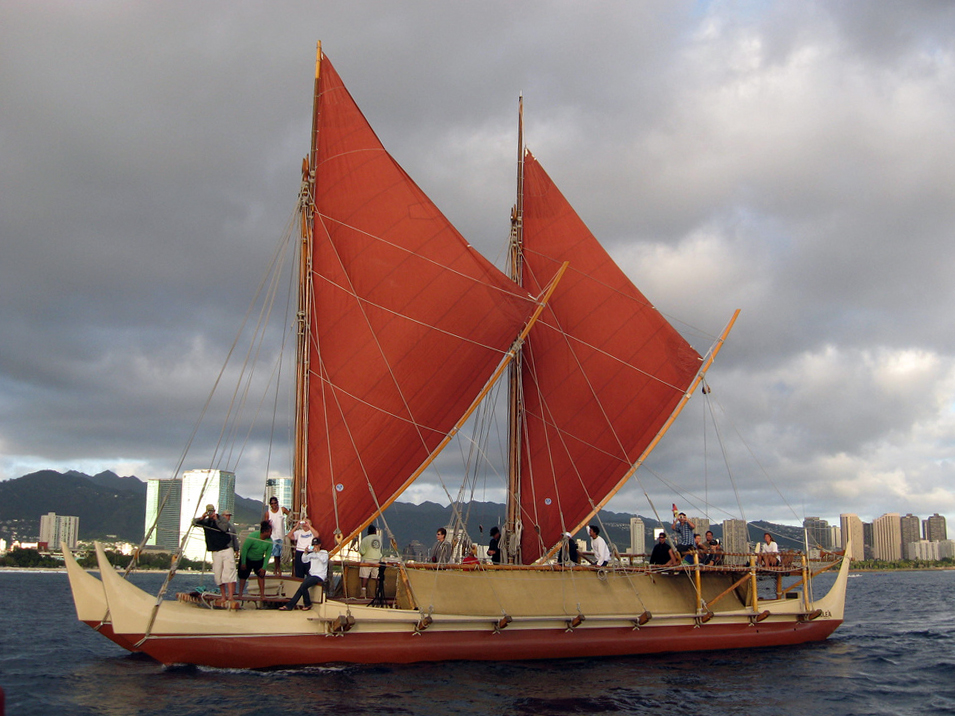
Hōkūle`a, a Hawaiian wa'a kaulua or voyaging canoe, sailing off Honolulu, photo taken from onboard the Chinese junk Princess Taiping, January 22, 2009. by Hong Kong Huey
Mālama Honua Worldwide Voyage to Engage ‘Island Earth’
Two double-hulled voyaging canoes, the Hōkūle‘a and Hikianalia, are waiting for fair winds from the right quadrant to depart from Hawaii on a three year voyage around the world. The Mālama Honua Worldwide Voyage, which means “to care for our Earth,” is the Hawaiian name for the voyage. Their mission is to find and grow inspiring practices to protect our earth for future generations.
Guided by island traditional wisdom, the Mālama Honua Worldwide Voyage seeks to highlight the need for action to safeguard the planet. Using only traditional navigation methods, a group of navigators from the Polynesian Voyaging Society will soon embark on this epic canoe voyage around the world to spotlight the need for sustainable solutions to global challenges.
The Mālama Honua Worldwide Voyage will cover 47,000 nautical miles using only the signs of the waves, winds and traditional 'way-finder' methods, utilising the stars, to find their way around the Earth. The launch of the voyage began yesterday (May 30th) 12 pm Hawaiian time - 10.30 am (May 31st)Australian time.
The Hōkūle‘a canoe will sail from Hawaii to Tahiti in the first leg of the trip and is expected to arrive in Apia, Samoa, in time for the Third International Conference of Small Island Developing States in early September. Under the theme of “sustainable development of small island States through genuine and durable partnerships,” the Conference will seek to ensure economic growth and social development while protecting the environment and increasing countries’ resilience.
“Living on an island chain teaches us that our natural world is a gift with limits and that we must carefully steward this gift if we are to survive together,” the crew said in a statement.
“The Worldwide Voyage is a means by which we now engage all of Island Earth—practicing how to live sustainably, while sharing, learning, creating global relationships, and discovering the wonders of this precious place we all call home.”
The navigators will bring the stories of islands and oceans to inspire leaders to take action to protect these critical resources. The Hōkūle‘a and Hikianalia crew will then carry this message to in their visits to 85 ports and 26 countries, including 12 of UNESCO’s Marine World Heritage sites, through to June 2017. The first stop for Hōkūle‘a and Hikianallia is Tahiti, where Hōkūle‘a made her first voyage in 1976. When Hōkūle‘a completed this maiden voyage it was the first time in 600 years that a Polynesian voyaging canoe sailed across the Pacific Ocean.
“As we embark on this voyage today, we are honored to join a global movement towards a more sustainable world,” said Nainoa Thompson, president of the Polynesian Voyaging Society, at the May 17, 2014 launch. “Mālama Honua allows us the special opportunity to perpetuate the legacy of our ancestors and inspire stewardship of the earth, sharing our aloha for our environment while nurturing and learning from local solutions and relationships.”
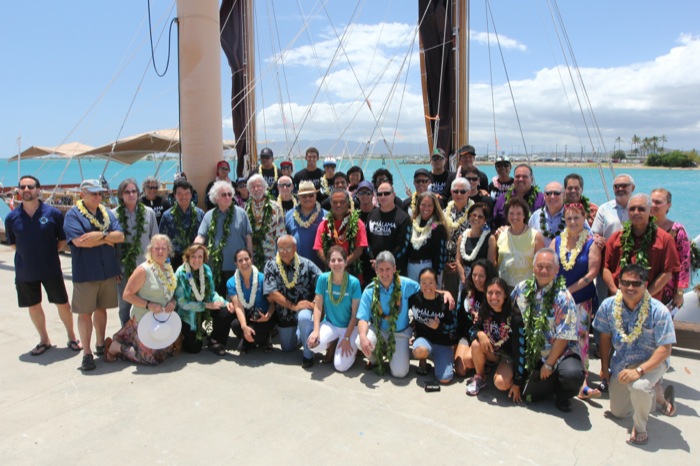
Thompson was joined by his fellow OceanElders to celebrate the launch of this historic voyage: a collective of leaders including renowned oceanographer Dr. Sylvia Earle, musician and activist Jackson Browne, and ocean exploration pioneers Jean-Michel Cousteau and Captain Don Walsh.
“The State of Hawai‘i applauds the Polynesian Voyaging Society and the countless volunteers, crewmembers, and partners of the Mālama Honua Worldwide Voyage for their truly remarkable and courageous efforts to take our cultural knowledge and values to the sea and around the globe,” said Hawai‘i State Lieutenant Governor Shan Tsutsui. “Mālama Honua will be a symbol of our cultural pride in every part of the world it visits, educating communities about the importance of appreciating and protecting each other and our earth.”
Throughout the voyage, crew members will educate communities and students of all ages around the world. Hōkūle‘a and Hikianalia will be “floating classrooms” powered by Google products and will share knowledge through a broad range of educational opportunities and partnerships. The program seeks to support and cultivate the next generation of navigators and explorers – helping young crew members to embody and value the lessons of Mālama Honua that will continue to thrive long after the wa‘a and crew return home.
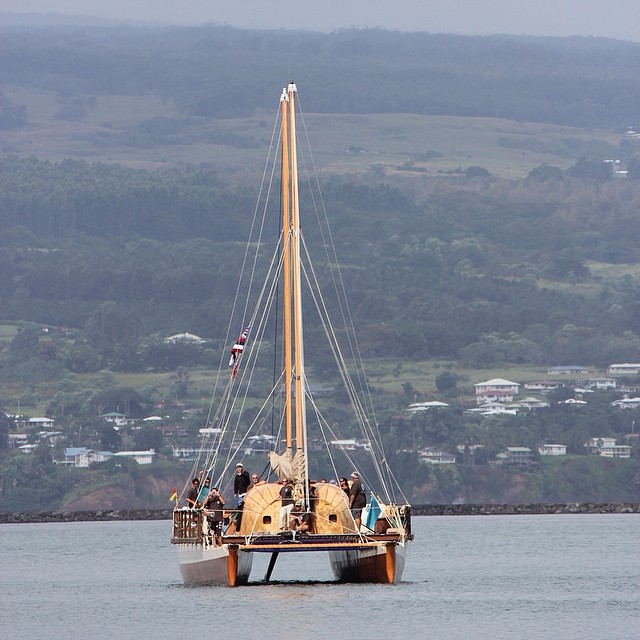 The Hōkūle‘a canoe will be accompanied by its sister canoe the Hikianalia which is also its modern-day counterpart. Equipped with state-of-the-art communications technology, like Google Hangout capabilities, the Hikinalia will document the worldwide voyage and share it with the rest of the world.
The Hōkūle‘a canoe will be accompanied by its sister canoe the Hikianalia which is also its modern-day counterpart. Equipped with state-of-the-art communications technology, like Google Hangout capabilities, the Hikinalia will document the worldwide voyage and share it with the rest of the world.
The name Hikianalia is the Hawaiian term for the star Spica, the sister star to Hōkūle‘a. Hikianalia (Spica;) and Hōkūle‘a (Arcturus: ‘star of gladness’) both appear on the eastern horizons together and travel in tangent across the night sky.
Hikianalia (right), has taken the voyaging canoes of Hawai’i one step further in technology. With no carbon footprint, her engines are electric, she will be the media hub powering laptops and camera batteries and she is powered through renewable energy resources like solar energy onboard. She is a model for clean ocean transportation and resource sustainability, in line with the MalamaHonua mission.
The voyage also coincides with the International Year of Small Island Developing States, which celebrates the contributions that this group of countries has made to the world.
“This historic voyage demonstrates the profound capacity and relevance of ancestral knowledge in our global effort to restore the Earth for future generations.” said Janeen Olds, Kamehameha Schools board chair, who donated two million dollars towards the enterprise on May 17th.
Facebook page: www.facebook.com/hokuleawwv
Google hangout: plus.google.com/+Hokulea/posts
Polynesian Voyaging Society Website: www.hokulea.com/
________________________________________
This Thursday is World Environment Day 2014 – June 5th.
The celebration of World Environment Day began in 1972 and has grown to become one of the main vehicles through which the United Nations encourages positive action for the environment. Through WED, UNEP enables everyone to realize not only the responsibility to care for the Earth, but also reminds one and all of their individual power to become agents of change. Every action counts, and when multiplied by a global chorus, becomes exponential in its impact.
WED is a big celebration, engaging millions across the globe through events on the ground in over 70 countries. Every year, participants, young and old, organize clean up campaigns, art exhibits, tree-planting drives, concerts, dance recitals, recycling drives, social media campaigns and different contests themed around caring for the planet.
The UN General Assembly declared 2014 as the International Year of Small Island Developing States to celebrate the contributions that this group of countries and territories has made to the world. In support of the UN designation of 2014 as the International Year of Small Island Developing States (SIDS), WED this year will adopt SIDS in the broader context of climate change as its theme.The UN's objectives are to help build momentum towards the Third International Conference on SIDS in September and encourage a greater understanding of the importance of SIDS and of the urgency to help protect the islands in the face of growing risks and vulnerabilities, particularly as a result of climate change. We believe WED will be an excellent opportunity to raise a call for solidarity with the islands.
"Planet Earth is our shared island, let us join forces to protect it."
UN Secretary-General Ban Ki-moon at the launch of the 2014 International Year of Small Islands and Developing States
These small islands are home to vibrant and distinct cultures and heritage as well as to rich ecosystems, biodiversity and dazzling landscapes. From Trinidad and Tobago to Tonga, Samoa to Suriname, the problems that these small islands face – climate change, waste management, unsustainable consumption, degradation of natural resources, extreme natural disasters in the midst of overpopulation and continuing industrialization – are the problems that face us all.
Climate change is foremost among these challenges, as global warming is causing ocean levels to rise. According to the International Panel of Climate Change (IPCC), global sea levels are rising at an increased rate which is projected to be even greater this century. When global temperature warms, seawater expands and occupies more space. Sea levels rise when ice melts as well. Coastal communities in every country are then threatened with floods and storm surges, to which these small islands are the most exposed. Many of these islands’ inhabited areas and cultural sites are potentially in danger of being lost to sea-level rise.
However, these islands have also been successful in overcoming their environmental problems. From Palau to Puerto Rico, the stories of resiliency and innovation abound. For instance, Tokelau recently began producing 100% of its energy from solar sources. In Fiji, lacking the resources to make new drainage systems and seawalls, local residents are restoring mangroves and coral reefs to help prevent flooding and erosion. These stories and solutions can be applied to environmental concerns all over the world.
The UN International Year of Small Island Developing States also seeks to raise awareness in preparation for the UN Conference on Small Island Developing States, which will be held in September 2014 in Samoa, and will focus on building partnerships for sustainable development.
The WWV, using ancient knowledge to inspire contemporary solutions, provides a great opportunity for oceans and islands issues to be discussed this World Environment Day and throughout the years their voyage will take. Learn more about Hōkūle‘a's Worldwide Voyage at www.hokulea.org
Hokulea WWV Overview 6 min from Oiwi TV on Vimeo.
Background information
Polynesian Voyaging Society
Mission
Founded on a legacy of Pacific Ocean exploration, the Polynesian Voyaging Society seeks to perpetuate the art and science of traditional Polynesian voyaging and the spirit of exploration through experiential educational programs that inspire students and their communities to respect and care for themselves, each other, and their natural and cultural environments.
The Polynesian Voyaging Society was founded in 1973 for scientific inquiry into our history and heritage: How did the Polynesians discover and settle small islands in ten million square miles of ocean, geographically the largest “nation” on earth? How did they navigate without instruments, guiding themselves across ocean distances of 2500 miles? In 1973-1975, we built a replica of an ancient double-hulled voyaging canoe to conduct an experimental voyage from Hawai‘i to Tahiti in order answer these questions. The canoe was designed by founder Herb Kawainui Kāne and named Hōkūle‘a, Star of Gladness.
In the last three decades, Hōkūle‘a has sailed over 140,000 nautical miles throughout the Pacific including Rapa Nui and Aotearoa to complete the Polynesian triangle. She has inspired a renaissance of Pacific island navigation and since her launch 1975, there are now 25 voyaging canoes, 21 voyaging organizations and 1,000 active voyagers throughout more than 11 Pacific Island nations.
Through modern technological tools such as live streaming video and videoconferencing like Google Hangouts on Air, we are able to bring the world with us on this Voyage to share in our experiences, and to inspire communities everywhere to navigate towards positive change for all. Through the Worldwide Voyage of Hōkūle‘a and Hikianalia, we are committed to bridging and building upon ancient wisdom and modern technology, gathering and sharing stories of hope and stewardship of our Island Earth through a connected global network. Through modern technological tools such as live streaming video and videoconferencing like Google Hangouts on Air, we are able to bring the world with us on this Voyage to share in our experiences, and to inspire communities everywhere to navigate towards positive change for all.
Google Hangouts on Air will allow us to connect with viewers via video as if our viewers are with us in person, even when our canoes are far away, in the middle of the ocean or docked at a port on the other side of the world. Viewers will be able to see, listen, and interact with our crew in real time; but perhaps more importantly with a Google Hangout on Air, the video streams are archived to Youtube for future reference and viewing. We will offer these recordings as part of the on-demand resources available to the public via our website, Hokulea.com. Google Hangouts on Air are free to all participants.
Learning Center http://learningcenter.hokulea.com/
Polynesian Voyaging Society: http://www.hokulea.com/
Online teaching resources for Polynesian Voyaging Society http://pvs.kcc.hawaii.edu/
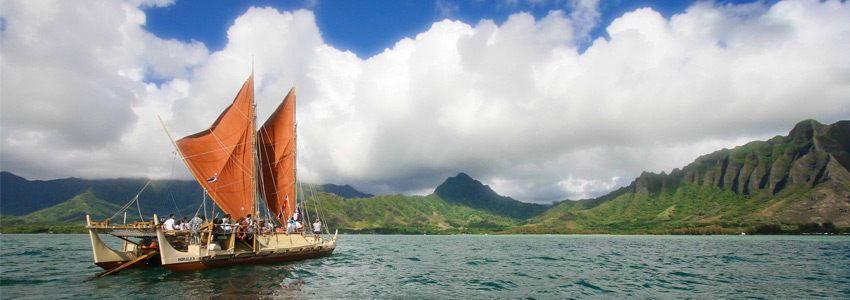
Our Vision
Hawai'i, our special island home, will be a place where the people, land and sea are cared for, and communities are healthy and safe.
Our Core Values
Aloha: To love
Malama: To care for
'Imi 'Ike: To seek knowledge
Lokomaika'i: To share with each other
Na'au Pono: To nurture a deep sense of justice
Olakino Maika'i: To live healthily
Our Guiding Process
The following describes the process that the Polynesian Voyaging Society has used to carry out successful voyages over the past 18 years. This planning, problem-solving, and decision-making process is taught in Malama Hawai'i education programs, and is used in establishing a basis for cooperative efforts in the community:
Vision and Values - Before beginning any project there must be a clear vision of the destination, and a strong commitment to reaching that destination. Our values steer our actions.
Planning-Once our destination and values are clear, then planning must begin to determine what information needs to be gathered, what tasks need to be accomplished, and who will be responsible for these tasks.
Building Community - In order to succeed at any large project there must be a community of people who support the vision and are willing to take responsibility for working toward it.
Preparation - Much preparation is needed for a safe voyage. The kind of preparation is determined in the planning phase. To prepare for a voyage we dry-dock the canoe to insure it is seaworthy, train the crew and navigator, and study the wind and weather patterns of regions where we plan to sail.
Risk-Taking - There comes a point when we must let go of the lines and set sail. In every voyage there is risk, but by being well prepared we do our best to minimize the risk.
Arrival - When we reach our destination, we celebrate our accomplishments and recognize the hard work of the community of people that supported the vision. We also take the opportunity to reflect on what we learned and experienced during the process of reaching our destination.
Sharing - Through education we share the lessons, experiences, and achievements of a voyage with students and the larger community, thus perpetuating what is valuable to us in what we have done.
History of the Polynesian Voyaging Society: 1973 - 1998
The Polynesian Voyaging Society (PVS) was established in 1973-by Dr. Ben Finney, an anthropologist from California, Herb Kane, a Hawaiian artist; and Tommy Holmes, a man who loved the sea-to show that the ancient Polynesians could have the purposefully settle the Polynesian Triangle in double-hulled, voyaging canoes using non-instrument navigation. The Society's first project was to construct a replica of an ancient voyaging canoe. On March 8th, 1975 this replica, Hokule'a, the first voyaging canoe to be built in Hawai'i in more than 600 years, was launched.
On May 1st, 1976 Hokule'a left Hawai'i on her maiden voyage to Tahiti, attempting to retrace this traditional migratory route. Navigated without instruments by Micronesian navigator, Mau Piailug, the canoe arrived 33 days later in Papeete, Tahiti, to a crowd of more than 17,000-over half of the island had turned out to greet the canoe. What had begun as a scientific experiment to prove a theory about the settlement of Polynesia, had touched a deep root of cultural pride in Polynesian people.
After the voyage Mau returned to Micronesia, and with him went the knowledge of the traditional art of wayfinding. But Mau had ignited a strong interest in many members of the Voyaging Society to continue sailing and learning about navigation. In 1978 in response to this interest, Hokule'a again left for Tahiti. Six hours into the voyage, in the middle of the night, Hokule'a capsized between O'ahu and Lana'i. In an heroic effort, Eddie Aikau, one of Hawai'i's most experienced ocean men left on a surf board to get help for his fellow crew members. He was never seen again. Eddie's loss was a painful experience, but it raised the standards of preparation and safety to a new level; since 1978 not a single crew member has been lost at sea.
Recognizing that it was unprepared to conduct a long voyage, PVS turned to Mau and asked him to teach them about sailing and navigation. Mau agreed, and for the next two years he helped prepare the members of the Voyaging Society for the enormous task of sailing and navigating a deep sea voyage. In 1980 a crew from Hawai'i successfully sailed Hokule'a to Tahiti and back to Hawai'i, but this time the canoe was guided by one of Mau's students, Nainoa Thompson, the first Hawaiian to navigate a voyaging canoe in more than 600 years.
From 1985-87, Hokule'a sailed more than 16,000 miles of traditional migratory routes from Hawai'i to Tahiti, Rarotonga (Cook Islands), Aotearoa (New Zealand), Tonga and Samoa-the Voyage of Rediscovery. This voyage demonstrated that it was possible to navigate these routes without instruments, and that contrary to popular theories, it was possible for traditional voyaging canoes to sail against the prevailing winds, by taking advantage of seasonal wind shifts. Hokule'a's voyages to date had demonstrated that the ancient Polynesians could have intentionally settled the Polynesian Triangle - an area of 10 million square miles, the largest nation on Earth - one of the greatest feats of exploration in human history. But while scientific research was the impetus for these initial voyages, the recovery and perpetuation of Polynesian voyaging and navigation traditions became the main emphasis. The voyages of Hokule'a inspired pride among Polynesians for their history and heritage, and sparked a revival of interest in canoe building, sailing, and navigation.
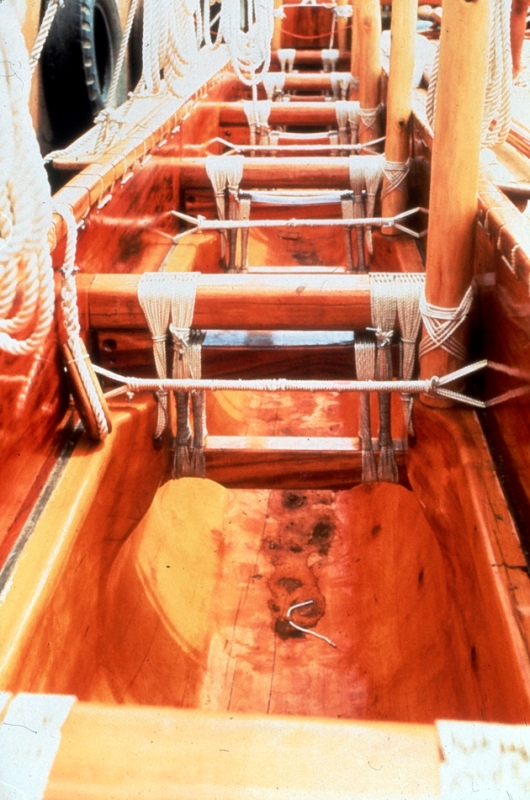 In 1990 in recognition of the impact of voyaging on the revival of Hawaiian culture, the Native Hawaiian Culture and Arts Program, an organization working to strengthen the Hawaiian community based on its common history and heritage, contracted PVS to construct a double-hulled, voyaging canoe made entirely of natural materials. A 9-month search of the Island of Hawai'i's koa forests resulted in nothing-not a single koa tree large enough or healthy enough for the hulls of a voyaging canoe was found. The ancient Hawaiians built hundreds of voyaging canoes from koa trees, but in 1990, given the decline of Hawai's native forests, we were unable to build even one. This taught the Voyaging Society a powerful lesson: the health of our culture is strongly tied to the health of our environment. Fortunately for the project, there was another historical source of wood for canoes-drift logs from the Pacific Northwest. In an extraordinary act of kindness, the native people of Southeast Alaska gave two, 400-year old, spruce logs to the Society to build a voyaging canoe. The effort brought together community groups, organizations, and countless individuals who contributed more than 500,000 hours to build and sail the canoe. The canoe, named Hawai'iloa, was completed under the leadership of Wright Bowman, Jr. Launched in 1993, Hawai'iloa, represented a new level of community involvement in voyaging, a new appreciation for Hawai'i's environment, and the start of a deep friendship with the native peoples of Southeast Alaska.
In 1990 in recognition of the impact of voyaging on the revival of Hawaiian culture, the Native Hawaiian Culture and Arts Program, an organization working to strengthen the Hawaiian community based on its common history and heritage, contracted PVS to construct a double-hulled, voyaging canoe made entirely of natural materials. A 9-month search of the Island of Hawai'i's koa forests resulted in nothing-not a single koa tree large enough or healthy enough for the hulls of a voyaging canoe was found. The ancient Hawaiians built hundreds of voyaging canoes from koa trees, but in 1990, given the decline of Hawai's native forests, we were unable to build even one. This taught the Voyaging Society a powerful lesson: the health of our culture is strongly tied to the health of our environment. Fortunately for the project, there was another historical source of wood for canoes-drift logs from the Pacific Northwest. In an extraordinary act of kindness, the native people of Southeast Alaska gave two, 400-year old, spruce logs to the Society to build a voyaging canoe. The effort brought together community groups, organizations, and countless individuals who contributed more than 500,000 hours to build and sail the canoe. The canoe, named Hawai'iloa, was completed under the leadership of Wright Bowman, Jr. Launched in 1993, Hawai'iloa, represented a new level of community involvement in voyaging, a new appreciation for Hawai'i's environment, and the start of a deep friendship with the native peoples of Southeast Alaska.
In 1992 Hokule'a made its fourth voyage to the South Pacific, sailing to Rarotonga for the Sixth Pacific Arts Festival, part of which celebrated the revival of canoe building and traditional navigation. New canoes were being built in Aotearoa, Rarotonga and Tahiti, and with help from PVS, new navigators were being trained for the next voyage: from the Marquesas Islands, the ancestral home of the first Hawaiians, to Hawai'i. In 1995 six canoes-Hokule'a, Hawai'iloa, and Makali'i from Hawai'i, Te 'Aurere from Aotearoa, and Takitumu and Te 'Au Tonga from Rarotonga-left the Marquesas Islands for Hawai'i. Five of the six canoes were navigated using only traditional methods, and all six arrived safely in Hawai'i.
Both the 1992 and 1995 voyages emphasized education, an important tool essential to sharing the experiences and values of voyaging with a larger audience. In addition to training new navigators and voyagers, PVS reached out to thousands of school children in the Department of Education through a long-distance education program. During the voyage students tracked the canoe on nautical charts, learned about their Pacific world, and used the canoe and its limited supply of food, water, and space, to explore issues of survival, sustainability, and teamwork. On the 1992 return voyage PVS educational programs reached as far as the Space Shuttle, as Shuttle crew member Lacy Veach, a Hawai'i native, participated in conversations about sustainability and exploration with the canoe and Hawai'i classrooms. In addition to these programs, PVS also began navigation and sailing courses at the University of Hawai'i and Windward Community College.
Within days of arriving in Hawai'i after the 1995 voyage, Hokule'a and Hawai'iloa were shipped to Seattle. Hokule'a sailed south along the West Coast, reaching thousands of people who no longer lived in Hawai'i, but longed to share in the canoe's legacy. Hawai'iloa sailed north to thank the native peoples of Southeast Alaska for their gift of spruce trees. This was an opportunity for PVS to give back to them, but at each stop the canoe and crew were overwhelmed with gifts and kindness. These native people were responding to the fact that, like them, the Hawaiians were working to recover their native traditions. This Northwest Voyage taught PVS a great deal about another culture's efforts to renew its traditions, and about their determination to care for natural resources, in order to build a healthy future for their people.
In 1999, the Voyaging Society closed the Polynesian Triangle by sailing to the remote island of Rapa Nui.
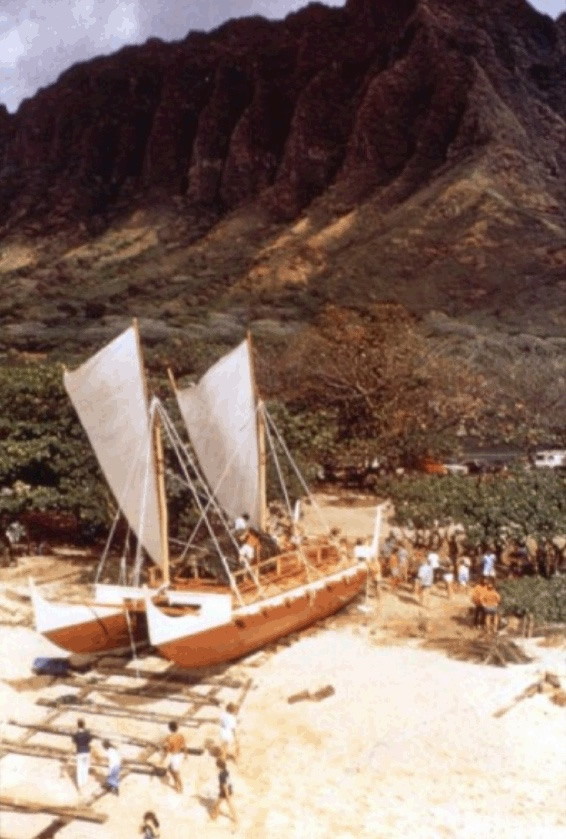 In the wake of her accomplishments, Hokule'a has helped to renew the pride that Hawaiian people have for their culture and heritage. In turn this has made a contribution to raising the self-esteem of Hawaiian people. Recognizing that self-esteem and health are inextricably linked, a cooperative effor emerged in 1996 between The Queen's Health Systems and the Polynesian Voyaging Society, called Malama Hawai'i-"Caring for Hawai'i." Native Hawaiians have the worst health and socioeconomic indicators of any ethnic group in Hawai'i, and for years Queen's was been working to improve these statistics. Malama Hawai'i's first project was the 1996-97 Statewide Sail, a 10-month, 2,000 mile journey, in which more than 25,000 school children and community members visited or sailed on Hokule'a. The Sail was an effort to "connect" with Hawaiian communities, in order to find ways to support efforts to improve their health. What Malama Hawai'i found was cultural renewal taking place within these communities. Every community that Hokule'a visited celebrated its strengths with pride, and did not define itself by negative statistics. The Statewide Sail helped Malama Hawai'i to understand that the lives of the next generation of Hawaiians are already being shaped by this spirit of cultural renewal, and because of it we believe that in the future they will not be burdened with the same negative health and socio-economic statistics of the past.
In the wake of her accomplishments, Hokule'a has helped to renew the pride that Hawaiian people have for their culture and heritage. In turn this has made a contribution to raising the self-esteem of Hawaiian people. Recognizing that self-esteem and health are inextricably linked, a cooperative effor emerged in 1996 between The Queen's Health Systems and the Polynesian Voyaging Society, called Malama Hawai'i-"Caring for Hawai'i." Native Hawaiians have the worst health and socioeconomic indicators of any ethnic group in Hawai'i, and for years Queen's was been working to improve these statistics. Malama Hawai'i's first project was the 1996-97 Statewide Sail, a 10-month, 2,000 mile journey, in which more than 25,000 school children and community members visited or sailed on Hokule'a. The Sail was an effort to "connect" with Hawaiian communities, in order to find ways to support efforts to improve their health. What Malama Hawai'i found was cultural renewal taking place within these communities. Every community that Hokule'a visited celebrated its strengths with pride, and did not define itself by negative statistics. The Statewide Sail helped Malama Hawai'i to understand that the lives of the next generation of Hawaiians are already being shaped by this spirit of cultural renewal, and because of it we believe that in the future they will not be burdened with the same negative health and socio-economic statistics of the past.
What began in 1973 as a scientific experiment to build a replica of a traditional voyaging canoe for a one-time sail to Tahiti, became an important catalyst for a generation of cultural renewal and a symbol of the richness of Hawaiian culture and of a seafaring heritage which links together all of the peoples of Polynesia. No one could have imagined that by the end of the century, Hokule'a will have sailed more than 100,000 miles reaching every corner in the Polynesian Triangle, and the West Coast of the United States. In 1973 there were no Polynesian voyaging canoes; today there are six with others under construction. In 1973 there was only one deep-sea navigator that PVS knew of; today there are nine, with several more in training, along with 135 experienced deep-sea sailors in Hawai'i alone-ensuring that the Hawaiian people will never again lose their traditions of voyaging and navigation. Over the last 25 years, the family of the voyaging canoe has grown to more than 525,000 men, women and children who have participated in PVS programs of education, training, research and dialogue.
From PVS website
Above right photo: 1975: Launching Hōkūle‘a, at Hakipu‘u-Kualoa, Kāne‘ohe Bay
On January 23, 2007 the Hokule‘a and the Alingano Maisu set sail on a voyage to Micronesia and Japan. In March 2007, the canoes arrived at Piailug's home island of Satawal where five native Hawaiians and sixteen others were inducted into Pwo as master navigators. The event was the first Pwo ceremony on Satawal in 50 years and the Alingano Maisu was presented to Piailug as a gift for his contribution in reviving wayfinding navigation.
Hawaiian Star Lines and Names for Stars
Note: The night sky charts below that extend to the left and right margins of the text may be larger than they appear in this html file. You can view the larger charts by dragging the images from the browser onto your desktop, then opening them with graphic-viewing software. For print versions of the night-sky charts that would use less toner , you can use the Invert function in a graphic program like Photoshop (Image>Adjustments>Invert) to reverse the image (i.e., create a chart with a white sky and dark stars).
The wayfinder memorizes the position of stars on the celestial sphere in order to use them as directional clues when they rise and set. On cloudy nights, when only parts of the sky are visible, he may recognize isolated stars or star groups and imagine the rest of the celestial sphere around them.
To help remember the pattern of stars in the sky, Nainoa Thompson has organized the sky into four star lines, each line taking up about one fourth of the celestial sphere:
Ke Ka o Makali‘i ("The Canoe-Bailer of Makali‘i")
Iwikuamo‘o ("Backbone")
Manaiakalani ("The Chief's Fishline")
Ka Lupe o Kawelo ("The Kite of Kawelo")
One way to remember the sequence of the four quadrants of the sky is to remember it geometrically :
1. a curve (Ke Ka, "The Canoe-Bailer"); followed by 2. a line (Iwikuamo'o, sometimes called the "North-South Star Line"); followed by 3. a triangle (Manaiakalani contains the three bright stars of the Navigator's Triangle); followed by 4. a square (the fourth quarter of the sky includes the Great Square of Pegasus).
Or the line can be remembered as a sequence of objects:
1. a bowl or bailer (Ke Ka); followed by 2. a backbone (Iwikuamo'o); followed by 3. a fishhook (Manaiakalani is the name of Māui's fishhook); followed by 4. a kite (Ka Lupe).
The star lines appear one after another in the sky.
For more charts depicting these star lines rising and setting, see “Star Lines Rising and Setting”.) at:http://pvs.kcc.hawaii.edu/ike/hookele/hawaiian_star_lines.html
What are a few of the differences between Hikianalia and Makali'i?
Uncle Chadd and Crew's Answer:
A few of the differences between Hikianalia and Makali'i are:
Canoe length: Hikianalia 72' - Makali'i 54'
Sails: Hikianalia has 2 Masts - Makali'i has 1
Bunks: Hikianalia has actual foam bunks for crew to sleep in Makali'i does not
Engines: Hikianalia has a solar powered engine in each hull Makali'i has no engine
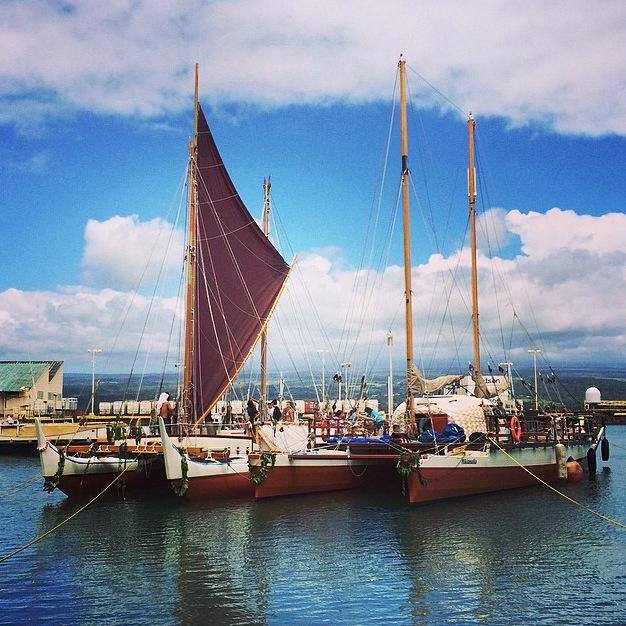
In Search of the Ancient Polynesian Voyaging Canoe (1998) By Herb Kawainui Kāne- founder of the Polynesian Voyaging Society and designer of Hōkūle‘a (1928-2011): See his article at: http://pvs.kcc.hawaii.edu/ike/kalai_waa/kane_search_voyaging_canoe.html
Iz ~ Hokule'a Star of Gladness
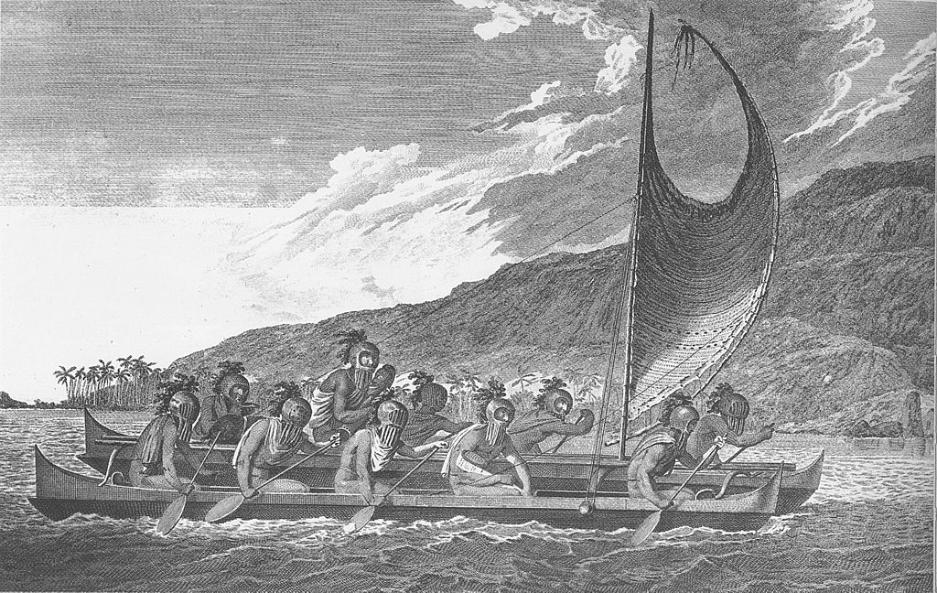
Priests travelling across Kealakekua bay for first contact rituals. Each helmet is a gourd, with foliage and tapa strip decoration. A feather surrounded akua is in the arms of the priest at the center of the engraving. It is not known what the purpose of the ritual surrounding first contact with Westerners was. Artist: John Webber, artist aboard Cook's ship, ca 1781.